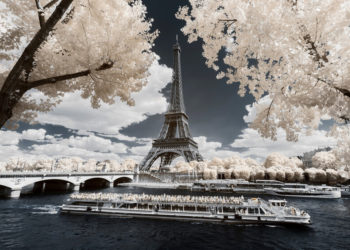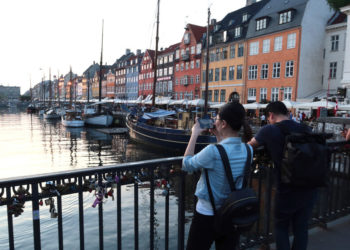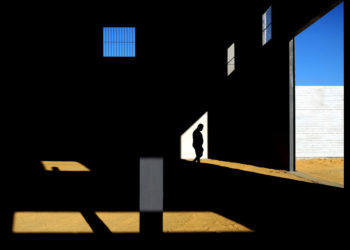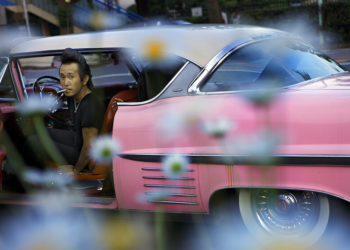In February of this year we met the winners of the ‘National Awards’ at the Sony WPA. This selection is the outstanding work of the competitors of the Open category and is carried out in a special way in 51 countries. We have been able to interview the winner of the Colombian National Award, Andrea Ortiz Días, who explains to us through her work how we can make an award winning series or image.
Andrea Ortiz Díaz is a plastic artist specialized in photography with experience in project management and university teaching. His work focuses on the self-portrait, the hybrid processes of analog and digital photography and the analysis of the relationship between natural and artificial elements in space.. It has also been the winner of several awards at the Colombian level in addition to its recent award of the National category of the WPA.
During our interview, the first thing Andrea tells us about is the process of her winning photograph.

‘Night in the Tatacoa desert’ by Andrea Ortiz Díaz | Winning Photography
‘Night in the Tatacoa desert’ is the winning photograph. It was captured on December 21, 2020 and it was a special experience while doing a photographic series on the relationship of the body with the natural landscape. Through the self-portrait we seek to analyze the scale relationship of the body and the landscape. For this, it was necessary to find elements of the landscape that are similar to the body and in this way generate in the viewer that unconscious relationship of space that invites him to observe and read the photographic painting.
Part of the idea of capturing the desert at night is that there is a preconception that the desert is an arid space with lots of sun. So, to break this scheme, the night was used, with moonlight conditions, which allowed us to explore the place from the dark. This also modified the vision giving importance to the darkness to take the photographs.

Photo by Andrea Ortiz Díaz
Here is the challenge of finding the parts of the body in the landscape or also how to place the body within that landscape. A methodological process had to be developed. For it, each of those spaces was captured with long exposure and flash output. This implied seeing the space, thinking of a light scheme that mixed the continuous light of the landscape with the flash of flash that molded the volume of that space of tropical dry forest.
Following this context, Andrea advises us from her workflow how as photographers we can plan and produce a photographic series.

Photo by Andrea Ortiz Díaz
The stages from pre-production to post-production expand to a notion of life. Previous experiences, both photographic and extra-photographic, help to give more depth to the investigation of the product in question. In this sense, they are not only our experiences, but those of other photographers and people who have traveled those places where we create our photographs. This allows us to approach the research and design of the project with a different look than that of only the main function of going to shutter and now. We apply a concept and ideas behind the shots.
It is also important to have a technical planning for the moment of the shot. In addition to technical photography, in landscape photography it is important to take into account elements such as accommodation. Since it is convenient to have a site that allows us to get to the location of the shot quickly without wearing too much to get to the shot. This is important since sometimes, staying too far is missing opportunities to be able to walk or explore a place with greater tranquility.

Photo by Andrea Ortiz Díaz
Likewise, get to know our teams. It is important to know how to handle our equipment without seeing the settings and to be able to navigate and improve the shot. That will help us to be more aware of the scene and the creative without worrying about knowing if you are staying or not. Among these technical aspects, working with the greatest amount of information.
Finally, after capturing the shot, it is important to visualize the project in post-production. Give the context and articulation to the narrative series and the photographs to tell our story. Know where the shots are going to arrive and participate. Andrea believes that in the case of this series, it would not be the same to send her to participate in the portrait category as in the landscape category, since the context of where it is presented changes that narrative. That is why it is important to take it into account.

Photo by Andrea Ortiz Díaz
Then we asked Andrea about the importance of entering contests and some advice on how to refine our photographic work to present the best of ourselves.
The first thing the photographer tells us is that you have to take advantage of a contest like the Sony WPA, which are free. You also have to believe in your work. By putting our photographs into competition, we learn and think in depth how our image is articulated to a social context or a political context of a country. In this exercise of putting our images into competition, we learn a lot about how to read and articulate images.

Photo by Andrea Ortiz Díaz
On the other hand, Andrea tells us that it is important to read a lot of photography and other arts. Although you develop your own visual identity, you are constantly permeated by other powerful works. This reading of the other works also helps us to identify elements in our images that make us see what works or what can complement our work to be better. For example: color palettes, narrative, composition.

One trick is to have a work log. Ideas and moments are captured here. When you are already in the process of carrying out the work, that is where the ideas and form of the photographer as a creative artist rest. Ideas evolve and having this written down can help us organize and further improve this project.

Photo by Andrea Ortiz Díaz
But most of all humility to learn from other people, to know how to receive advice and to adapt to changes that may occur when doing a project. One can be very proud and ignore, but there are people who see the world from other aspects that we can be ignoring. So being open to learning from other ideas and seeing if they complement our work is also very important.
What other elements do you think is necessary in this development of photographic series?
To learn more about Andrea’s work, do not hesitate to visit her website or her Instagram.









Discussion about this post